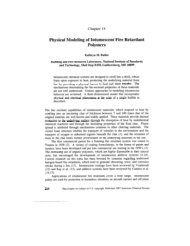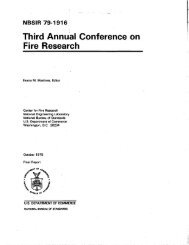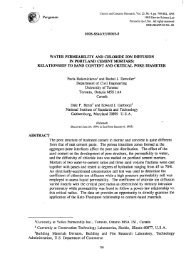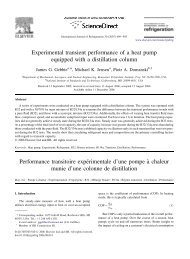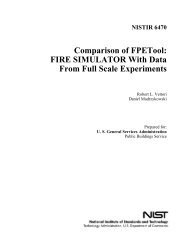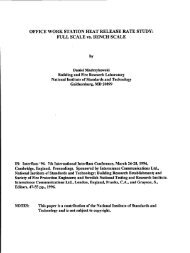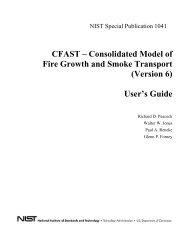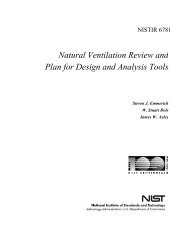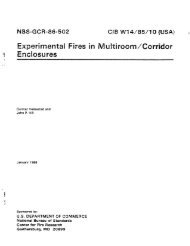Study of Technology for Detecting Pre-Ignition Conditions of ... - NIST
Study of Technology for Detecting Pre-Ignition Conditions of ... - NIST
Study of Technology for Detecting Pre-Ignition Conditions of ... - NIST
Create successful ePaper yourself
Turn your PDF publications into a flip-book with our unique Google optimized e-Paper software.
located onthefloor atthe door opening. At least one fire extinguisher was located near the<br />
doomay and someone trained in fire containment was always nearby when ignition was<br />
imminent.<br />
3.0 R~SUltS ~~d Discussion<br />
3.1 General Experimental Results<br />
The results <strong>of</strong> the pwaettic experiments are further discussed in this section. The main<br />
focus is on the ins~mented experiments and the possibility that any <strong>of</strong> the measurements<br />
recorded can lead to pre-ignition detection.<br />
3.1.1 Parametric Experiments<br />
The parmetric experiments were primarily <strong>of</strong> interest <strong>for</strong> assistance in the selection <strong>of</strong><br />
the pans used in the instimented tests. The temperawre behavior <strong>of</strong> these tests is <strong>of</strong> some<br />
additional interest. Figure 4 depicts the temperature versus time curves <strong>of</strong> the parametric tests<br />
<strong>for</strong> which temperature was m~nitored. Both <strong>of</strong> the tests using stainless steel pans (shown as solid<br />
lines) ignited, while the others which used aluminum pans (dashed lines) did not. The two tests<br />
<strong>of</strong> diflerent amounts <strong>of</strong> com oil in a stainless steel sauce pan show similar tempera~re behavior,<br />
except the one using the smaller mount caused compression <strong>of</strong> the curve in time. The tests <strong>of</strong><br />
different mounts <strong>of</strong> corn oil in a cermic-mated aluminum pan also show similar behavior<br />
except the one using the smaller mount also caused time compression <strong>of</strong> the curve. The tests<br />
<strong>of</strong> 250 mL <strong>of</strong> corn oil in two kinds <strong>of</strong> aluminum pans show similar behavior. Oil heated in<br />
aluminum pans on this typical gas range fell short <strong>of</strong> ignition temperaties by at least 30 “C.<br />
The last two parametric tests were mndudd on the open-coil electric range. The baked<br />
beans test shows a very long water evaporation time, about 1500 seconds, until the temperature<br />
begins to rise slmrply over 100 “C. Heating was continued <strong>for</strong> several minutes after smoke<br />
production had decreased to a low level. The bean residue consisted <strong>of</strong> a dry char and ash. The<br />
last test was mndu~ed using an aluminum frying pan with 250 ti <strong>of</strong> corn oil which did ignite<br />
after approximately 12 minutes, but the temperature was not monitored. This test demonstrated<br />
the ability <strong>of</strong> the electric range to ignite oil in a.n aluminum pan.<br />
3.1.2 Ins~mented Experiments<br />
A total <strong>of</strong> twenty-two tests, listed in Table 3 and consisting <strong>of</strong> twelve combinations <strong>of</strong><br />
range, food, and hood status, were conducted <strong>of</strong> which eighteen produced ignition and did not<br />
experience problems with data mlle~ion or operational procedure. Seven <strong>of</strong> the test<br />
combinations were repeated. Test one was repeated twice because the initial heating level was<br />
too low. Tests six and seven were the only tests conducted on the smoothtop range because test<br />
six did not produce ignition, and additional unsuccessful tests were considered likely to occur.<br />
The reds <strong>of</strong> the ins~mentd experimen~ are provided primarily in graphical <strong>for</strong>m<br />
One test <strong>of</strong> oil heated on the electric range with the range hood <strong>of</strong>f is used as a typical example<br />
18



